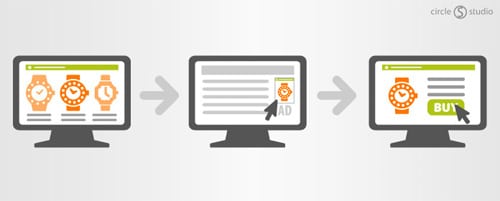Only about 2% of first time visitors to a company’s website are ready to make a purchase. The B2B sales cycle can be quite long, so leveraging retargeting technology can be a great way to bring potential leads back to your website that didn’t “convert” the first time.
While retargeting continues to gain traction in B2B marketing, forty-six percent of search engine marketing professionals believe retargeting is the most underused online marketing technology available. Due to it’s effectiveness in reengaging previous website visitors and helping to convert leads, your B2B online marketing program could greatly benefit from this technology.
What is retargeting?
Retargeting, also called remarketing, is a marketing technology that helps reengage prospects who have previously visited your website by showing them ads as they browse the web. It allows you to promote a product or service to people who have previously interacted with your company, but just might not be ready to purchase yet—keeping you top of mind and increasing brand awareness.
Search retargeting is not the same thing as site retargeting. Search retargeting focuses on engaging new prospects that have an interest in your product or service but might not be aware of your brand yet. However, this post will focus on using site retargeting to attract prospects back to your website and increasing conversions.
Site retargeting can be accomplished in several ways such as display ads, search, banner ads, etc. Here are a few companies that provide this service:
– Google Adwords Remarketing
– ReTargeter
– AdRoll
– FetchBack
– Perfect Audience
Why site retargeting matters
Site retargeting is an effective way to target a narrow audience and nurture leads. It’s an alternative to mass digital advertising, and is a way to spend your advertising dollars more wisely—targeting people that have already peaked an interest in your brand. Retargeting can boost ad response up to 400%.
Site retargeting complements the longer B2B sales cycle since it keeps your brand top of mind with prospects as they research and do their due diligence. Retargeting could even help shorten the sales cycle by nurturing leads. It also provides an opportunity to cross sell other products or services you offer that complement the original item.
Best practices
Retargeting is best utilized by segmenting your visitors to provide the most relevant ads possible. For example, if one visitor looked at Product A, you’ll want to segment them from visitors that looked at Product B. Segmenting allows your campaign to provide the most relevant ads possible and increase your chances of clickthroughs.
Once visitors do come back and purchase a product, you will want to either remove them from your retargeting list or add them to a different list that promotes a similar or complimentary product or service.
Monitor, test and tweak consistently. Don’t just create your retargeting campaign and let it run its course. In order to have a successful campaign, you will need to monitor it and change your ads depending on their clickthrough rates.
Concerns around retargeting
Most likely we’ve all been exposed to retargeting. Some advertisers are concerned that retargeting is too intrusive or “stalker-like.” Others sometimes see it as spam. However, it’s really no more intrusive than any other type of online marketing—as it uses cookies stored on your computer to track your online activity. And no matter what, you are always going to see online ads. So why not have them actually be relevant to you?
/ / /
Retargeting is an effective way to convert prospects into customers, especially for B2B companies with a longer sales cycle. By following best practices, you’ll be able to spend your online advertising budget more wisely and convert more of your prospects into customers.




